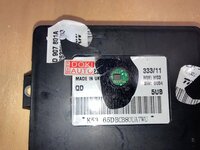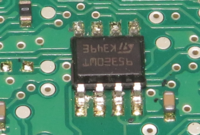Not so difficult as I initially thoughtPassat NMS switch E538 below.
View attachment 104394
Sharan 7N (2010–2015) & Tiguan 5N (2007–2016) switch E538 below.
View attachment 104395
Not so easy but I think my desired modification is possible.
 .
.

Not so difficult as I initially thoughtPassat NMS switch E538 below.
View attachment 104394
Sharan 7N (2010–2015) & Tiguan 5N (2007–2016) switch E538 below.
View attachment 104395
Not so easy but I think my desired modification is possible.
 .
.

Cheers.Great work!
Did you manage to get the EPB ECU to work?
I’m planning on retrofitting EPB to my Golf VI.
As @pulken has suggested my controller has a hole under the sticker and eeprom chip has been resoldered.My seller has left me with no other option but to go public.
My test.
And this is test performed by @dnoermann.


So i got the Unit from @Robert for analysis.Be careful with this module I bought one from that specific seller it was not working. Same did a another guy in Turkey same module, does not work. I bet you will have a hole under your label at the TRW location where they have drilled in and modified the EEPROM.




 .
.

 .
.


Hi, cool project.Ladies and gentlemen, let me present you my (world's first?)
VW Transporter/Multivan/Caravelle T6 with Electronic Parking Brake
I just need to complete the wiring of my PARKING BRAKE indicator in INSTRUMENT CLUSTER and AUTO HOLD.
Yes, I meant if it needs to be actively getting valid data from the can bus to lock/release the brakes, or would it run standalone. I assume it waits or requests some data like vehicle speed or other, but would it run without it?ECU? Do you mean CAN bus?
First release of EPB was implemented by BMW on 7 Series (E65) back in 2001.
Electronic Parking Brake as a system has been designed to be integrated component of vehicle network system.
It exchanges a lot of info/data, via Power-train CAN-Bus, with Engine, DSG, ACC, IC, BCM, etc.
Additionally EPB is a certified replacement of Manual Parking Brake
and thus compliant with the following standards FMVSS 105, FMVSS 135, ECE 13H.
And this means that EPB can also be used as a secondary/emergency brake.
At glance EPB appears to be just 2 servomotor calipers controlled by the switch
but this is only one part of this very sophisticated system.
Generally servomotors are being used at speed of 8km/h and lower
which means that they are designed for stationary use as a purely parking brake.
Applying EPB at higher speeds is the second part of this system.
In such a scenario EPB controller sends CAN messages to the ABS and requests hydraulic braking to take place.
This braking is called "Emergency Braking" and it is capable of safely stopping vehicle in very controlled manner from any speed.
It uses anti-lock functionality and by default it brakes using all 4 wheels with predefined intensity.
EPB adaptations allow for a lot of adjustments and tweaks,
among which "Emergency Braking" intensity and braking axle selection are the most important.
There is a selection of 7 intensity levels and "Emergency Braking" can be set to use rear axle only or both.
So taking into account all of the above and what is most important safety of all road users EPB can not be used as a stand alone system.
The most obvious concern would be applying EPB via servomotors and locking rear axle wheels at high speed.
Second lot arrived tooAnd finally my first lot of EPB controllers has arrived.
This time brand new and genuine VW made by TRW.
Fully functioning and working.
Already tested on bench and in the vehicle.
Also with @dnoermann's involvement
we have verified BCM compatibility and these modules work with all revisions of
BCM PQ25 Max4 7E0 937 090(no letter/A/B/C/D).
View attachment 109908
View attachment 109909
View attachment 109910
 .
.
